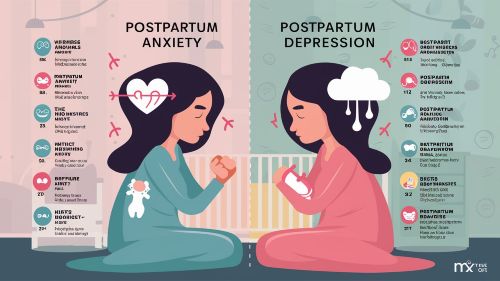You pictured motherhood differently. You imagined overwhelming joy. You expected a magical bond. But your reality feels… off. You are not constantly crying. You are not the textbook case. But something is wrong. This is for you.
Postpartum depression (PPD) is a sneaky thief. It does not always arrive with a storm of tears. Often, it tiptoes in. It wears clever disguises. It looks like exhaustion. It feels like normal “new mom” stress. Doctors see this every day.
They see mothers suffering in silence. They are waiting for the “big” signs. But PPD often lives in the small moments. The subtle shifts. Recognizing these quiet signs is the first step. It is the most powerful step toward feeling like yourself again.
This guide will uncover those hidden signs. We will explore the symptoms doctors wish every new parent knew. You are not alone in this. Help is closer than you think.
[Note for WordPress Editor: Add a Table of Contents here using a plugin like “Easy Table of Contents”. This will automatically generate links to all the H2 and H3 headings below, which is excellent for user experience and SEO.]
Beyond the Blues: Why “Subtle” Is So Important
Many people confuse PPD with the “baby blues.” This confusion is dangerous. It stops moms from seeking help. They think their feelings are normal. They believe they just need to “tough it out.” Let’s clear this up.
The baby blues are common. They affect up to 80% of new mothers. They start a few days after birth. They last about two weeks. Symptoms include mood swings, anxiety, and sadness. But they are temporary and usually mild.
Postpartum depression is different. It is a medical condition. It is more intense. It lasts much longer. PPD can appear anytime in the first year. It interferes with your ability to function. It does not just go away on its own.
[Note for WordPress Editor: The following section would be visually effective in a two-column layout or a comparison block in the WordPress editor.]
| Baby Blues | Postpartum Depression (PPD) |
|---|---|
| Lasts up to 2 weeks | Lasts longer than 2 weeks |
| Mild mood swings, tearfulness | Intense sadness, anger, or numbness |
| Comes and goes | Feelings are persistent and constant |
| You can still feel joy | Difficulty feeling pleasure (anhedonia) |
| Does not impair daily function | Significantly impacts daily life |
| Resolves on its own | Requires support and treatment |
The subtle signs of PPD are critical. They are the early warning system. They often hide in plain sight. Dismissing them as “just being a tired mom” can delay crucial treatment. Knowing them empowers you.
[Insert an empathetic image of a mother looking tired but thoughtful, not overly sad. Alt Text: A mother contemplates her feelings, a subtle sign of postpartum depression.]
The Hidden Emotional Signs of PPD
PPD is a mood disorder. But the mood isn’t always “sad.” Doctors are seeing a wider range of emotional symptoms. These are often the most misunderstood signs.
1. Overwhelming Irritability or Rage
You expected tears. You did not expect rage. You feel a constant, simmering anger. Small things set you off. The baby crying. Your partner asking a question. A dish left in the sink. It all feels like too much.
This isn’t a character flaw. It is a classic but subtle sign of PPD. Your brain’s emotional regulation is off-balance. The frustration builds with no release. It comes out as anger and irritability. You might feel ashamed of this feeling. You are not a bad person. You are struggling.
A doctor might say: “We often see moms who don’t feel sad. They feel angry. They feel like they could scream. They snap at everyone they love. This is PPD, too. It’s your brain signaling for help.”
2. Apathy and Emotional Numbness
This is perhaps the cruelest sign. You love your baby. You know this in your head. But you do not feel it in your heart. You feel… nothing. There is a pane of glass between you and the world. You are just going through the motions.
Changing diapers. Feeding the baby. Rocking them to sleep. It feels like a checklist. There is no joy. No connection. This emotional emptiness is called anhedonia. It’s a core symptom of depression. It is terrifying for a new mother.
You might think, “I am a monster.” You are not. This numbness is a protective mechanism. Your brain is overwhelmed. It shuts down feelings to cope. It is a sign you need urgent support.
3. Pervasive Guilt and Self-Doubt
Every mother feels a little guilt. PPD takes this to an extreme. You feel like you are failing at everything. You believe you are a bad mother. You are convinced your baby deserves better.
You might compare yourself to others. You see moms on social media. They look happy and perfect. This deepens your sense of failure. This intense, irrational guilt is not just “mom guilt.” It is a cognitive distortion. It is a symptom of PPD twisting your thoughts.
4. Inability to Relax or “Switch Off”
You are exhausted beyond belief. Yet, you cannot sleep when the baby sleeps. Your mind races. You feel a sense of dread. You are constantly on high alert. Is the baby breathing? Is the house safe? What if something bad happens?
This is more than normal new-parent worry. This is postpartum anxiety. It often co-exists with PPD. You feel wired and tired. You cannot relax, even for a moment. This constant state of hyper-vigilance is mentally and physically draining.
[Note for WordPress Editor: Use a “Key Takeaway” or styled quote block here for emphasis.]
Key Takeaway: Postpartum Depression isn’t always crying. It can be anger, numbness, extreme guilt, or constant anxiety. These feelings are valid chemical signals, not character flaws.
The Sneaky Physical & Behavioral Signs
PPD does not just live in your head. It manifests in your body and actions. These physical symptoms are very real. They are often the first things you notice. But they are easy to blame on something else.
[Insert an image of a calendar with many crossed-out days. Alt Text: A calendar representing brain fog and forgotten tasks, a physical sign of PPD.]
5. Major Changes in Appetite or Sleep
“Sleep when the baby sleeps.” You have heard it a million times. But you can’t. You lie awake for hours. Or, you want to sleep all the time. Sleep is your only escape. Neither extreme is healthy.

The same goes for food. You might have zero appetite. Food tastes like cardboard. You forget to eat for hours. Or, you might be eating constantly. You use food for comfort. Significant changes in sleep or appetite are major red flags for depression.
6. Pervasive “Brain Fog”
You feel like you are losing your mind. You cannot focus. You walk into a room and forget why. You struggle to make simple decisions. What should I make for dinner? Which onesie should the baby wear? These small choices feel monumental.
This is more than “mommy brain.” This is a cognitive symptom of PPD. Depression impacts executive function. It affects memory, concentration, and decision-making. It is not a sign of your intelligence. It is a sign your brain needs help.
7. Unexplained Aches and Pains
Your head constantly hurts. Your stomach is always in knots. Your muscles ache for no reason. You have been checked by your doctor. There is no physical cause. These are called somatic symptoms.
Depression can cause real, physical pain. The emotional stress manifests in your body. If you have persistent aches, pains, or digestive issues with no clear medical explanation, consider your mental health. It could be a physical cry for help.
8. Withdrawing From Your Support System
You used to love seeing friends. Now, it feels like a chore. You make excuses to avoid visitors. You screen your calls. You feel like no one understands. You worry they will judge you.
This isolation is a common PPD behavior. The illness tells you to pull away. But connection is what you need most. Withdrawing from people who love you is a sign that PPD is taking control. It thrives in secrecy and isolation.
9. Obsessive Thoughts or Compulsive Behaviors
This is a very distressing symptom. You have scary, intrusive thoughts. They pop into your head unwanted. Often, they are about the baby getting hurt. These thoughts horrify you. This is not the same as wanting to harm your baby. It is a sign of PPD/anxiety.
You might also develop compulsive behaviors. You check the baby’s breathing constantly. You sanitize bottles over and over. You must have things a certain way. These are attempts to control the overwhelming anxiety PPD creates. They are not a sign you are “crazy.”
Why Are These Signs So Often Missed?
These signs are subtle. They are masters of disguise. Several factors contribute to why moms, families, and even doctors can miss them.
- The “Perfect Mother” Myth: Society expects new moms to be blissful. We feel immense pressure to appear happy. Admitting we are angry or numb feels like a personal failure.
- Overlap with “Normal” Postpartum Life: Extreme fatigue? Brain fog? That’s just being a new mom, right? It can be hard to tell where normal ends and PPD begins.
- Fear of Judgment: Many mothers are terrified. They fear if they admit their feelings, they will be labeled a bad mom. They even fear their baby could be taken away. This fear is a huge barrier to seeking help.
- Lack of Awareness: Many partners, family, and friends do not know these subtle signs. They look for constant crying. If they don’t see that, they assume everything is fine.
[Note for WordPress Editor: Consider embedding a short, relevant YouTube video here from a trusted source like Postpartum Support International or a medical channel, discussing PPD symptoms.]
What Doctors Want You To Do: Your Action Plan
Recognizing yourself in these signs is scary. But it is also incredibly brave. It is the first step on the road to recovery. Here is what doctors and mental health experts want you to do next.
Step 1: Acknowledge and Validate Your Feelings
Your first job is to be kind to yourself. Say it out loud. “I might have postpartum depression. This is not my fault. This is a medical condition.” Drop the guilt. Drop the shame. You did not cause this. You are not to blame.
Step 2: Talk to Someone You Trust
Break the silence. PPD’s power is in secrecy. Choose one person. Your partner. Your mother. A trusted friend. You do not need to have all the answers. Just say, “I am not okay. I am struggling. I need help.”
Conversation Starters:
- “I’ve been feeling really angry lately, and it’s scaring me.”
- “I know I should be happy, but I just feel numb.”
- “I can’t seem to turn my brain off. I’m worried all the time.”
- “Can you help me make a doctor’s appointment? I’m having a hard time.”
Step 3: Schedule a Doctor’s Appointment
This is a non-negotiable step. Your mental health is as important as your physical health. Call your OB-GYN or your primary care physician. They are trained to handle this. They are your frontline support.
Be honest with them. You can even bring a list of your symptoms. Tell them about the irritability. Tell them about the brain fog. Tell them about the numbness. The more they know, the better they can help you. They want to help you.
[Link to your article on ‘How to Talk to Your Doctor about PPD’] (Internal Link)
Step 4: Explore Treatment Options
PPD is highly treatable. You have options. Your doctor will help you create a plan. This is a collaborative process. Your treatment might include one or more of the following:
- Therapy (Psychotherapy): Talking with a therapist is incredibly effective. Cognitive Behavioral Therapy (CBT) and Interpersonal Therapy (IPT) are proven to help with PPD.
- Support Groups: Connecting with other moms who “get it” is validating. It reduces isolation and shame. Look for local or online groups.
- Medication: Antidepressants can be life-changing for PPD. They help correct the chemical imbalance in your brain. Many are safe for breastfeeding. Your doctor will discuss the risks and benefits.
- Lifestyle Support: This includes practical help. Getting more sleep. Eating nutritious food. Gentle exercise like walking. Asking for help with the baby so you can have a break.
[Link to a reputable source like Postpartum Support International’s helpline] (External Link for Trustworthiness)
Step 5: Practice “Micro” Self-Care
“Self-care” can feel like another pressure. Forget bubble baths and spa days. Focus on micro-moments. Tiny, achievable acts of kindness to yourself.
- Drink a full glass of water.
- Step outside for 5 minutes of fresh air.
- Listen to one favorite song with headphones.
- Eat a piece of fruit.
- Do a 2-minute stretching routine.
These small acts won’t cure PPD. But they signal to your brain that you matter. They are small anchors in the storm. They give you a tiny foothold to start climbing back.
Conclusion: You Are Not Alone, and You Will Get Better
Motherhood is a profound transformation. Sometimes, that process gets hijacked by a health condition. Postpartum depression is that condition. It is not a reflection of your love for your child. It is not a sign of your strength as a person. It is an illness. And illnesses can be treated.

The subtle signs—the anger, the numbness, the fog, the anxiety—are your body’s way of asking for help. Listen to it. Trust it. If this article felt like it was written about you, please take the next step. Make the call. Send the text. Talk to your doctor.
Recovery is not just possible; it is expected with the right support. You will feel joy again. You will feel that connection. You will feel like yourself again. You are a good mother, going through a hard time. And help is waiting for you.
Frequently Asked Questions (FAQs)
1. How do I know for sure if it’s PPD or just the baby blues?
The biggest differences are timing and severity. Baby blues are mild and last no more than two weeks after birth. PPD is more intense, lasts much longer (or can start months later), and significantly interferes with your ability to function and care for yourself and your baby. If your feelings persist past two weeks, it’s time to talk to a doctor.
2. Can PPD start a long time after the baby is born?
Yes. While many think PPD only happens in the first few weeks, it can develop at any point during the first year after giving birth. The onset can be gradual, which is why these subtle signs are so important to recognize, even at six or nine months postpartum.
3. Can my partner get postpartum depression?
Absolutely. Paternal postpartum depression is real and affects a significant number of new fathers. They can experience similar symptoms, including sadness, anger, anxiety, and withdrawal. It’s crucial for the entire family’s well-being that fathers also seek support if they are struggling.
4. Will I definitely have to take medication if I have PPD?
Not necessarily. Treatment is personalized. For mild to moderate PPD, therapy, support groups, and lifestyle changes can be very effective. For more moderate to severe PPD, a combination of therapy and medication is often the most effective route to recovery. Your doctor will discuss all options with you.
5. What if I’m too scared to tell my doctor the truth about my feelings?
This fear is very common. Remember, doctors are medical professionals bound by confidentiality. They have heard it all before and are there to help, not judge. If you’re nervous, try writing your symptoms down and handing them the paper. You can also say, “I think I might have postpartum depression, can we talk about that?” They will guide the conversation from there.
